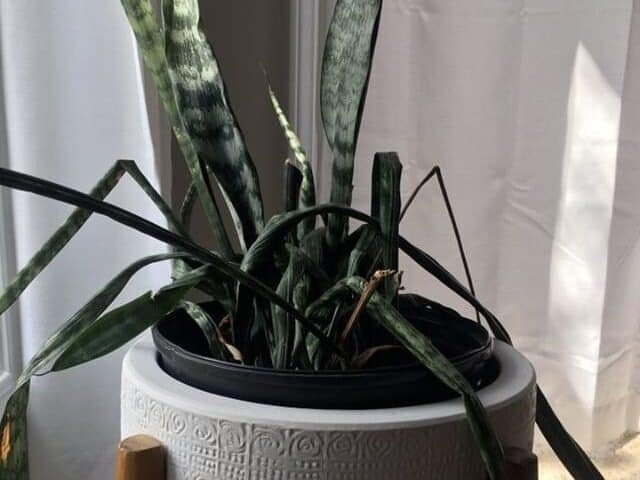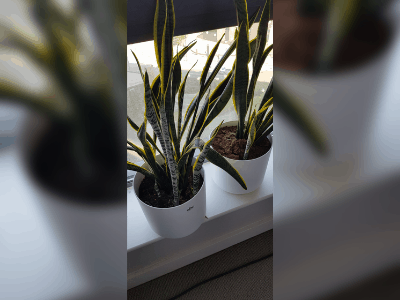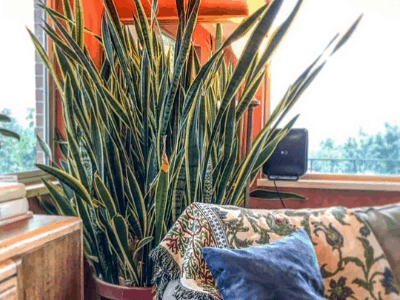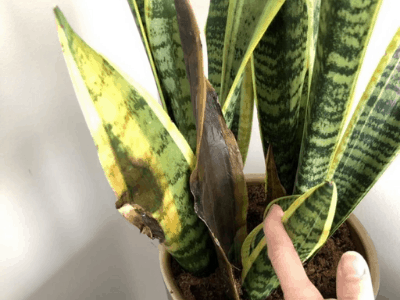So What’s The Problem?

Shriveling Leaves on Snake Plant
Seeing your snake plant leaves yellow and wrinkled is so frustrating, but it’s no longer an issue.
To keep snake plants from getting wrinkled, water them regularly, but let us proceed to the list of other factors that we must pay attention to:
- Time of the year
- Watering
- Type of potting soil used
- Light conditions
- Shock
- Temperature and humidity
- The size of the pot
We will discuss each topic in detail, as well as how to identify and prevent wrinkled leaves on snake plants.
Let us begin our mini-lecture now!
But before that, here we have story from Finn, about his experience having shriveling leaves on snake plant issue.
Prices pulled from the Amazon Product Advertising API on:
Product prices and availability are accurate as of the date/time indicated and are subject to change. Any price and availability information displayed on [relevant Amazon Site(s), as applicable] at the time of purchase will apply to the purchase of this product.
Let us hear Finn’s story
Sunday morning I wake up and surprise seeing what happened to my snake plant.
The leaves of the snake plant were shriveling. I was getting worried, but then I read about how they do…
…that to protect themselves from extreme heat or cold! That’s perfect for my place!
After that I do all of the things that required for saving this plant, and voila only in 3 months…
….this plant back to its healthy state! I’m so proud of my self!

Overwatering, under-watering, inappropriate potting mix, and humidity fluctuations are the primary cause of wrinkles in snake plants. The leaves are shriveling because the plant is dehydrated either due to under-watering or root rot. Physical damage during repotting can also lead to shriveling in a snake plant.”
Richa, author from simplifyplants.com
Here’s the main thing!
What Affects Shriveling Leaves on Snake Plant
Time of the Year
The snake plant, like any houseplant, enjoys its growth season from spring to summer.
Before we look at watering a snake plant, we’d like you to be clear as to the seasons and the snake plant’s growth.
The snake plant needs that period of time to dry out and is watered more often than normal.
But, one thing must be watched out for. Do not Overwater!
If the soil dries out easily, wrinkled leaves might result. Therefore, water the plant to keep it hydrated.
When we enter fall, the snake plant will need less water and enter its dormant period during the winter.
The snake plant will not show any additional growth during the dormant period as the plant is resting.
We severely reduce the waterings during the winter season to half the amount we water during the summer.
Now, there are a few things that we need to consider during the winter:
- Keep the snake plant away from cold drafts.
- Please avoid placing snake plants near radiators.
- The snake plant should be misted occasionally with the neem oil mix.
- Snake plants do not require fertilization during their dormant period
These things help reduce the chances of snake plants wrinkled since moisture is maintained in the air and humidity level is kept at par.

Go on…
Watering
If we discuss watering, then one of two things could happen:…
…either the plant gets overwatered or it gets underwatered.
In the case of the snake plant, both scenarios can result in it getting wrinkled.
We can understand how here.
You can view this link to get more information regarding watering techniques.
If you are curious about watering a snake plant,…
…you can go here: Watering Snake Plant Essentials: Important Factors to Consider.

Next up…
The Snake Plant is being submerged in water.
The snake plant is a succulent, which means it doesn’t need a lot of water. The leaves of the snake plant hold water.
Underwatering, on the other hand, is a no-no for plants.
As a result of dehydration, underwatered snake plants have curled and wrinkled leaves.
It’s also possible that the watering intervals need to be narrowed.
When the soil is too dry or the plant isn’t properly hydrated, snake plants wrinkle.
After being properly watered, we can observe that the plant has returned to normal.
There will be no more snake plant leaves folding.
Examine the soil to see whether the snake plant requires additional water.
Water the plant if the soil becomes too dry.
The snake plant also has another sign indicating that it is underwatered.
We will observe that it has brownish tips on its leaves. That is an indication that it is underwatered.
Season also plays an important role, as discussed above. Water the snake plant more frequently if it is summer than if it is winter.
In the summer, water the snake plant several times a week,…
…while during the winter water it once a month. Feel the soil for moisture needs.

Keep reading…
Overwatering of The Snake plant
This is the most common problem we encounter with snake plants because they tend to overwater easily.
Snake plants are succulents, and because of that, they need the soil to be dry before watering.
If we neglect a bit, then the snake plant may overwater.
The color of the leaves can also give us a clue to whether the plants have been overwatered.
Snake plants develop brown tips when underwatered, however, overwatering reduces their leaf color…
…and causes the leaves to become yellow or brown. If neglected, they will start shedding their leaves.
Despite the overwatering, the snake plant might also get root rot, which attracts pests, which wrinkles the snake plant.
How To Avoid Overwatering?
We can avoid the overwatering situation by:
- Make sure the snake plants get the water they need by probing the ground before watering.
- A soil that is dry and not moist should be used.
- Ensure the drainage holes are not blocked; if so, clean them.
- Get rid of excess water that might have accumulated in the drainage tray.
- Make sure you use a well-draining potting soil mix.
- You will need to make a watering schedule.
- If required, attach a note to the plant, or we can use reminders.
During winter, the snake plants enter a dormant period during which little water is required.
Sometimes they will require water within a month or even two.
Type of Potting Soil Used
Medium from which plants get their nutrients and minerals.
Hence, the soil, which is the growing medium must be fresh.
We have an article about mixing soil for snake plants in our blog.
Go here: 3 Superb Amazing Tips Choosing Good Soil for Snake Plant.
In the case where we notice that a snake plant is getting wrinkled and all the factors are good…
…then it could be that needing new potting soil might help.
An older soil mix may have been lacking in nutrients and minerals,…
…therefore, needing new potting soil mix.
The snake plant might have been overwatered, or the soil…
…will become fertile and it will be able to flourish again.
If this is the case, repotting the plant in a different pot and using new potting soil will help it thrive again.
To repot, we will need:
- Well-draining potting soil mix
- Cactus soil mix
- Compost
- A new pot
Lets start repotting:
First, remove the plant from the older pot gently…
…and keep the plant along with the root ball under running water.
Now, mix the potting soil and the cactus soil in a 1:1 ratio. Add compost to the mixture.
Compost will take care of the micronutrient and the macronutrient factor.
Next, add the mixture to the new pot and place the roots in the pot’s center.
Be gentle during the process and make sure not to hurt the roots or cause any damage to it.
Once the roots are placed, add some more mixture of potting soil and compost.
Gently tap the pot to ensure that there are no air pockets formed.
Finally, water the plant. Provide the plant with enough indirect bright sunlight.
Upon repotting, the snake plant will come back to normal. When the plant is hydrated and healthy again…
…the wrinkles will disappear. Snake plants need light just like other plants do.
The plants need perfect lighting conditions in order to make photosynthesis.
Keeping a snake plant outdoors in bright indirect sunlight is necessary for healthy leaf development.
If the light is too intense or direct, the plant may burn. The light also affects the color of the leaves.
A snake plant kept under bright indirect light has a greener color on the leaves.
Keep snake plant leaves in low light conditions and they won’t be as healthy as those kept in high light conditions.
When stored in a dark spot, snake plant leaves begin to wrinkle, so they have to be moved to a place with plenty of light.
As the snake plants are kept inside in a dark spot, they will turn lighter in color and eventually lose their variegation.
If sunlight from the sun is not available, artificial light can be used as well.
Shock
The shock we refer to when it comes to snake plants is different than when it comes to plants that are housed.
In the event that the snake plant underwent stress during transport, its environment could have changed dramatically.
In such circumstances, the snake plant might take a while to adapt to new surroundings.
The leaves can begin to wrinkle at this point. Do not muck too much with it.
The snake plant needs a while to adjust to its new surroundings.
When the snake plant learns how to thrive in its new environment,…
…you will be able to see healthy growth again.
One potential cause of shock may be physical damage to the plant.
We explained previously that the snake plant practices the Chinese art of Feng-Shui, but high-traffic areas should be avoided.
Plants may become dangerous when located near high traffic areas such as the stairs, near the entrance, etc…
…when others could be unknowingly harm the plant unknowingly.
As a result, we must avoid locations where snake plants might suffer physical damage, and pets are another factor to consider.
Pet owners may mistreat snake plants, hurting both the snake plants and their pets.
Additionally, the plants will drop dead when they are handled.
Furthermore, they will be poisonous for any pets they may approach.
Because of this, we recommend that you use Spatial plantations and hanging pots if you have pets around.
Temperature and Humidity
The snake plant is very sturdy in case of temperature. However, the temperature below 10°C is not suitable for the snake plants.
If we see that the snake plants have wrinkled, then it could be during the winter, where the plants experience a cold draft.
We should keep the snake plant out of the cold draft and avoid using the southern window in winter.
This could also happen during the summers when high temperatures cause the water to dry up quickly…
…and the soil to be depleted. The soil drying quickly could result in the snake plant drowning.
During the winter season, we should regularly mist the snake plant, and if we want to deter pests…
…we can add a neem oil solution to the water.
Neem oil solution is a natural way to keep the pests away from snake plants.
It is important the snake plant is kept away from the radiators during winter and in places like the bathroom…
…to maintain the humidity. We can also use a humidifier to maintain the humidity.
Though it does not require extra humidity. a little misting will only benefit the snake plant.
Last but not least…
The Size of The Pot
If the pot is too large, chances are high that the plant will be over watered.
On the off chance that it is too small, the roots will grow entirely inside the pot and stop the development of the plant at one point.
The roots of snake plants need space to develop and may also be stunted. That could also result in stunted growth.
Thus we generally move the plant to a larger pot once the plant has built up the roots.
It is an overall principle that if our plant is 1 foot in height, then we need a 2-gallon pot, and if the plant…
…is 2 feet in height, then a three-gallon pot will be required.
Depending on the size of the plant, you can adjust it accordingly. Check for the roots of the plant as well.
Once the roots have grown completely, it is the ideal time for a repot.
Pot Types You Should Choose
To choose the right container for your garden..
..you need to choose a material that fits your plant and growing conditions.
Pots for plants come in a variety of materials.
The following descriptions will help you choose the right pot.
Make sure the pot has drainage holes.
Terracotta
A traditional favorite. The prices of smaller and less ornate styles are more affordable..
..while larger and more elaborate styles can be quite costly and heavy.
Dryes out quickly..
..making it an ideal indoor pot for drought-tolerant plants and Mediterranean herbs like rosemary, sage, and thyme.
Terracotta that is glazed does not dry out as quickly. Terracotta can be damaged by freezing temperatures when it is used outdoors.
It is best to store empty through the winter in cold regions.
Plastic
Lightweight, durable, and affordable. You can choose from bright colors or classic terracotta tones…
…to create an enchanting setting. With outdoor pots, direct sun heats black plastic, which can harm roots…
…in hot climates. Alternative plastic containers, such as buckets, bins, and tubs, are also an option.
These work well both indoors and outdoor.
Wood
Easily integrates into garden settings with its natural appearance.
However, it does deteriorate over time, and while wood is durable, it is also weather-resistant.
Half-barrel wooden containers are quite heavy once filled with soil, so position them in place beforehand.
Outdoor containers should be made of wood.
Glazed Ceramic
Beautiful colors often adorn these pots, which are strong and durable.
However, they can be pricey, though, and don’t stand up well to freezing temps.
Perfect for indoors.
Concrete
These containers are top-of-the-line in durability, but are expensive. It is extremely heavy. Best used outdoors.
Developing the Gardening Pot Size Chart
In order to figure out an average, I gathered as much data as I could..
..dropped the extreme numbers from either end..
..and looked at the frequency with which experts recommended a quantity.
Our recommendation is to focus on the volume of soil the pot should hold..
..and whether or not we recommend a minimum depth for the soil (e.g., at least 10″ for beets).
The remaining dimensions can be matched to whatever size pot you have available.
When your container doesn’t come with a label that tells you how much it holds..
..you can use your largest kitchen measuring tools..
..to find out by filling it within 1-3 inches of the brim with water or potting soil.
In addition..
..just imagine the joy you will feel when your housemates..
..or partner discover that you accidentally dumped dirt into the Pyrex measuring bowl..
..they use to measure pancake batter?
Don’t worry if all this sounds complicated!
When in doubt, go a size or two larger or get as close as you can.
Plants can’t read seed packet instructions, and they just want enough room to grow.
Points to remember
- With all of the seeds, there are different recommended minimum container size.
- Since there are no standard pot sizes, you could used: volume in pints or gallons, likely diameter of pots with the correct volume, and minimum soil depth for plants that are fussy about it.
- In the absence of a volume listed on your container, you can figure the volume by measuring the amount of soil you can fit into it using your largest kitchen measuring tools.
- The volume of some pots may be stated in measurements other than US customary units (gallons, etc.) and you can calculate it using our easy table or an online converter.
- Potted plants are grown for many reasons other than aesthetics and saving space. Mobility (control of the amount of sunlight and keeping your plants away from extreme temperatures), problems with the local soil (salty, polluted, etc. ), or being able to grow food out of the reach of animals like deer and rabbits (the deck or rooftop).
- If the wind is strong, plants with top-heavy growth may need to be anchored to prevent them from falling over.
- If you can’t find a pot of that exact size, choose a bigger one if you can. “Minimum recommended” means it should be at least that big. Furthermore, if you want healthy plants and a good harvest, you will have to water and fertilize them more often if you grow plants in “too small” pots.
- To fill large pots (3+ gallons), it is recommended to buy or mix “large container” potting soil, which usually contains bulky fillers like composted pine bark or coconut coir. Due to the fact that these fillers do not break down quickly, your soil will not become compacted or anaerobic before the season ends.
- Fertilizers labeled as “slow release” work based on temperature, so in warmer weather, they will disappear much faster than expected. To ensure our containers get what they need, we use organic liquid fertilizers more frequently. *Please note that growing in pots is very different from growing in-ground (plants’ roots have limited space from which to gather nutrients and water from). For this reason, we do not recommend using fertilizers for in-ground plants, but rather focusing on building biological soil fertility.
- One final note: you can purchase organic fertilizer, pots, growbags, raised beds, as well as other container gardening supplies.
Sum Up
See having Snake plant is good choice for you to have! It’s cool, its famous, it’s easy to have and care!
What else do you need? In this pandemic time like this, is a good choice for you to have an new activity…
…and having snake plant is a good choice for you to have!
Prices pulled from the Amazon Product Advertising API on:
Product prices and availability are accurate as of the date/time indicated and are subject to change. Any price and availability information displayed on [relevant Amazon Site(s), as applicable] at the time of purchase will apply to the purchase of this product.
Conclusion
One last thing for sure. Remember, love is also needed for snake plant care.
Alright that’s all for today! Do you have any questions about all of this?
Or do you want to add some method for having and care so shriveling leaves on snake plant wont be occurred again?
Let me know your recommendation from the comment below.
We hope you can now take care your snake carefully and grow it big!
Thanks for reading this article! Bye!
FAQ
How to tell if snake plant is growing?
The Sansevieria grows healthy if it possesses these characteristics.
Sansevieria takes two years to reach maturity and is a sluggish-growing succulent.
The snake plant should grow about an inch each month when cultivated in a well-lit location.
It’s possible that insufficient light or water is preventing your Sansevieria from growing or looking stunted.
How do you revive a shriveled snake plant?
Reviving Cold Damaged Snake Plants
When placed in a room that is constantly warmer than 50°F (10°C),…
…a snake plant that has been exposed to temps just a little below…
…that mark will recover from its curled appearance.
For more info, you can go to our article: Like A Magic You Can Revive Dead Snake Plant! Amazing Tips.
What does the Overwatered snake plant look like?
Signs of an overwatered snake plant include drooping, yellowing foliage, and unsteadiness.
To prevent the snake plant from dying, take it out of its container, trim any decaying roots,…
…and repot it in a new container with fresh potting soil. Put the plant in an area with strong, indirect light.
Will wilted snake plant leaves recover?
If the plant is treated and saved in time, Sansevieria can recover from overwatering.
Long-term exposure to damp soil can cause plants to develop severe root rot, a fungus that can quickly destroy the plant.
By first ceasing the watering and relocating the plant to a sunny area, you can start rescuing the plant.



